The 1.3 stable release features 7 new reproducible papers, multiple bug fixes, and a tutorial by Jeff Godwin.
According to the SourceForge statistics, the previous 1.2 stable release has been downloaded nearly 4,000 times, with more than 1,000 downloads in China. During the same period, there have been 41,028 read transactions and 994 write transactions in the Subversion repository. Ohloh.net characterizes Madagascar by a “mature, well-established codebase” and a “large, active development team“, the estimated project cost is $7,4 million.





